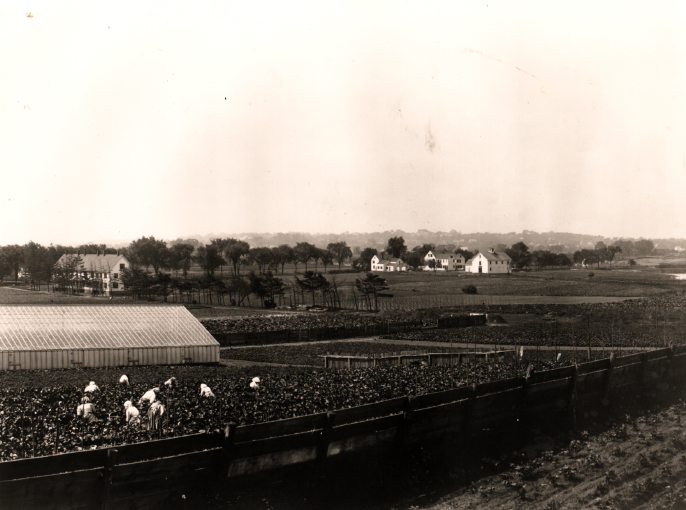Arlington's Farming History
Once upon a time Arlington had sixty farms! It was a thriving farming community. It was blessed with fine soils in East Arlington where it was said you had to go to the Heights to find a rock for a wall! Celery, lettuce, cabbages, cucumbers, beets were some of the primary crops.
Up in the Heights there were orchards and dairy farms. And then in the thirties farmers switched to flowers and the Town became known as the Gardenia capital of the World. One farmer estimated that there were 100 acres under glass — many greenhouses! Now, in 2010, there is not one farm in Arlington, and only a few greenhouses!
An Oral History of Arlington: Stories of Early 20th Century Life, available at Robbins Library and the Book Rack, is the primary source for a description of the farming industry. John 'Jerry' Crowley, the interviewer, grew up on a small farm, and he interviewed Daniel Purcell, a seed salesman and later Town Assessor, and he knew all about the different farms. Then he also interviewed farmers Howard Russell, Richard Wiggins, and Abner Wyman.
Arlington White Spine Cucumber, Crosby Egyptian Beet, Arlington Pascal Celery were vegetables actually developed by Arlington farmers! The celery of those times had no strings, and were tastier than today's disease resistant and tougher celery. The Crosby beet had nice green tops and no zoning in the beet itself. Interestingly the editor of the Stories book got a call from one Patrick Campobasso, long the school doctor at Arlington High, that the beet was in fact discovered by his father Joseph Campobasso, then a farmhand for Walter Crosby. He noticed the mutant beet, let it seed itself, saved the seeds, and planted them the next season! Later in time his father acquired his own farm in East Arlington — see the 1923 map of Arlington.
Howard Russell had a hill farm in Arlington Heights and raised a lot of cabbages and squash, which they fertilized with manure (remember horses were then used for the cultivation of the fields and for transportation as well up until the 1st World War and even after that). He described one advantage Arlington farmers had over farmers from other parts of the country — Italian women! They would take the trolley to Town from Boston, work all day for two dollars, and then walk back to the trolleys carrying tomato seconds and other vegetables on their heads for personal use! And sang as they walked! See the photograph of them harvesting beans at Wyman Farm (near Spy Pond).

The Gott Wagon factory in Town manufactured the farm wagons. A home industry described by Daniel Purcell was the making of bushel baskets. There was a fertilizer factory on Mill Street. There were market gardens all around in the surrounding towns — Belmont, Lexington, Bedford and Concord, and there would be a steady stream of horse drawn wagons heading for the Faneuil Market in Boston to purvey their vegetables. And the vegetables were even exported to New York and such distant venues as Florida. But then the refrigerated railroad car was invented, and draining the swamps, Florida came to grow the vegetables! And the land became to valuable to farm — all converted to houses! Now the government gives tax breaks to farmers to preserve the farms that are left.


